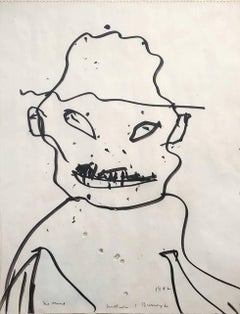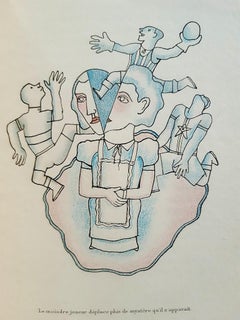William S. Burroughs Drawings and Watercolor Paintings
to
1
Overall Width
to
Overall Height
to
1
1
1
1
1
1
1
2
922
406
282
279
1
Artist: William S. Burroughs
No Name
By William S. Burroughs
Located in New York, NY
Black felt marker on paper with six bullet holes
Signed, titled, and dated, recto
This artwork is offered by ClampArt, located in New York City.
Willam Seward Burroughs (1914-1997)...
Category
1990s Contemporary William S. Burroughs Drawings and Watercolor Paintings
Materials
Paper, Permanent Marker
Related Items
Mr DOB By Takashi Murakami
By Takashi Murakami
Located in London, GB
Mr DOB
By Takashi Murakami
Takashi Murakami is a Japanese contemporary artist renowned for his vibrant and whimsical creations that blend traditional Japanese art with popular cult...
Category
2010s Contemporary William S. Burroughs Drawings and Watercolor Paintings
Materials
Paper, Ink
Le Secret Professionnel - Vintage Rare Book Illustrated by Jean Cocteau - 1925
By Jean Cocteau
Located in Roma, IT
Le Secret Professionnel is an original modern rare book illustrated by Jean Cocteau (Maisons-Laffitte, 1889 – Milly-la-Forêt, 1963) in 1925.
Published by Au Sens Pareil, Paris.
Original Edition.
530 numbered copies, one of the 440 copies on vélin d'Annonay.
Format: in 8°.
The book includes 105 pages with Twelve full page color drawings.
Mint conditions.
Jean Cocteau (Maisons-Laffitte, 1889 – Milly-la-Forêt, 1963). Jean Maurice Eugène Clément Cocteau was one of the most famous French writer, designer, playwright, artist and filmmaker. The novel Les Enfants Terribles (1929) and the films Blood of a Poet (1930), Les Parents Terribles (1948), Beauty and the Beast (1946) and Orpheus (1949) are his most appreciated works. His circle of friends, lovers and colleagues included Kenneth Anger...
Category
1920s William S. Burroughs Drawings and Watercolor Paintings
Materials
Paper
$2,690
H 9.34 in W 6.89 in D 0.2 in
Old Master Drawing, Baroque, Jacob de Wit, Allegory of Victory, Putti, Ships
By Jacob De Wit
Located in Greven, DE
Two putti with symbols of war and victory (cannons, cannonballs, armour, anchor, lion's head, laurel branch/ olive branch, flag, staff with helmet) in pediment triangle.
Probably a design for a painting or architecture
Pen-and-ink drawing in black on brownish paper, black wash
Plain gold moulding with UV glass
Allegory of Victory, 18th Century, Old Master Drawing, By De Wit, Figurative
Jacob de Wit...
Category
Late 17th Century Baroque William S. Burroughs Drawings and Watercolor Paintings
Materials
Paper, Crayon
$2,176 Sale Price
35% Off
H 8 in W 12.8 in
Putti in a Landscape, Putti playing, flowers, Berchet, French Art, Old Master
By Pierre Berchet
Located in Greven, DE
Pierre Berchet, Drawing of Putti playing in a landscape,
Painter of decorative history subjects; trained under La Fosse; worked in France and during the 1690s...
Category
17th Century Baroque William S. Burroughs Drawings and Watercolor Paintings
Materials
Handmade Paper
$1,722 Sale Price
20% Off
H 8.12 in W 12.09 in
Circle of Angelika Kauffmann, Venus and Amor, Arrow and Spindle, Oval Drawing
Located in Greven, DE
Fine drawing in pencil, oval format. Circle of Angelika Kauffmann.
The subject is not clear. It is Amor with his arrows and perhaps Venus with a sp...
Category
18th Century Romantic William S. Burroughs Drawings and Watercolor Paintings
Materials
Crayon, Handmade Paper
$1,148 Sale Price
20% Off
H 11.3 in W 9.06 in
Neues Album - Rare Book Illustrated by Wilhelm Busch - 1925
Located in Roma, IT
Neues Album is an original modern rare book illustrated by Wilhelm Busch (Wiedensahl, 15 aprile 1832 – Mechtshausen, 9 gennaio 1908) in 1925.
First augm...
Category
1920s William S. Burroughs Drawings and Watercolor Paintings
Materials
Paper
$538
H 12.6 in W 10.24 in D 0.79 in
The History of Amelia - Rare Book Illustrated by George Cruikshank - 1832
By George Cruikshank
Located in Roma, IT
The History of Amelia is an original modern rare book engraved by George Cruikshank (London, 1792 – London, 1878) and written by Henry Fielding in 1832.
Published by James Cochrane ...
Category
1830s William S. Burroughs Drawings and Watercolor Paintings
Materials
Paper, Etching
$298
H 6.7 in W 4.34 in D 0.2 in
Jonas Wood Original unique signed Flower drawing, to Kevin in hardback monograph
By Jonas Wood
Located in New York, NY
Jonas Wood
Original flower drawing by the artist held in hardback book, 2018
Hardback Monograph.
Hand signed, dated and inscribed with unique drawing by Jonas Wood on the title page....
Category
2010s Contemporary William S. Burroughs Drawings and Watercolor Paintings
Materials
Mixed Media, Permanent Marker, Offset
$2,000
H 10.25 in W 8.25 in D 0.75 in
Theatre Scene, Opera, Old Master Drawing, Griselidis, Mallet, French Art
Located in Greven, DE
Unknown Artist, French School 18th Century, Circle of Mallet? Scene taken from the Decamerone.
Old Master Drawing
Category
18th Century Romantic William S. Burroughs Drawings and Watercolor Paintings
Materials
Paper, Cardboard
$1,435 Sale Price
20% Off
H 21.74 in W 26.93 in
Untitled - grim reaper By Damien Hirst
By Damien Hirst
Located in London, GB
Untitled - grim reaper
By Damien Hirst
Damien Hirst is a British contemporary artist known for his provocative and often
controversial works that explore themes of life, death, and...
Category
Early 2000s Contemporary William S. Burroughs Drawings and Watercolor Paintings
Materials
Paper
Untitled Figurative by Miguel Conde, No. 102/150
By Miguel Conde
Located in San Diego, CA
Signed lithograph by awarded artist Miguel Conde. The artist is known for his mastery of engraving. His drawings and other art forms are sought after and his artwork is part of vario...
Category
20th Century Expressionist William S. Burroughs Drawings and Watercolor Paintings
Materials
Paper
$1,180 Sale Price
20% Off
H 29.25 in W 23.5 in D 1 in
Flemish School, Portrait Young Boy, Old Master Drawing, Baroque, 17th Century
Located in Greven, DE
Old Master Drawing, Flemish School, Portrait or Sketch of a standing young boy. Condition : see photos
The drawing is on paper.
Category
17th Century Baroque William S. Burroughs Drawings and Watercolor Paintings
Materials
Crayon, Paper
$765 Sale Price
32% Off
H 7.88 in W 5.52 in
William S. Burroughs drawings and watercolor paintings for sale on 1stDibs.
Find a wide variety of authentic William S. Burroughs drawings and watercolor paintings available for sale on 1stDibs. You can also browse by medium to find art by William S. Burroughs in paper, pen, permanent marker and more. Much of the original work by this artist or collective was created during the 1990s and is mostly associated with the contemporary style. Not every interior allows for large William S. Burroughs drawings and watercolor paintings, so small editions measuring 18 inches across are available. Customers who are interested in this artist might also find the work of Reginald K. Gee, Elena Borstein, and Laura Tanner Graham. William S. Burroughs drawings and watercolor paintings prices can differ depending upon medium, time period and other attributes. On 1stDibs, the price for these items starts at $8,500 and tops out at $8,500, while the average work can sell for $8,500.
Artists Similar to William S. Burroughs
Questions About William S. Burroughs Drawings and Watercolor Paintings
- 1stDibs ExpertApril 5, 2022How a Burroughs adding machine works depends on the model that you have. Look for the number along the sides on the bottom and then look for an authoritative online resource that provides step-by-step usage instructions. On 1stDibs, shop a variety of vintage adding machines.
- Who was William Plunkett?1 Answer1stDibs ExpertApril 5, 2022William Plunkett was a furniture designer whose work combined sculptural flair with engineering precision in the 1950s and 1960s. Plunkett contributed to post-war British design, and his pieces are still in high demand today. Shop a collection of vintage and modern William Plunkett furniture on 1stDibs.
- Was William Blake a Surrealist?1 Answer1stDibs ExpertNovember 20, 2024No, William Blake is not usually considered a Surrealist by art historians. Although his paintings, prints and poetry exploring the realm of the unconscious mind influenced the Surrealist movement that started in 1924, his work predates it and was part of 19th-century Romanticism. Some of his most famous artworks include The Ancient of Days, The Ghost of Fleas, Pity, Newton and The Great Red Dragon and the Woman Clothed with the Sun. On 1stDibs, explore a collection of Surrealist art.
- Why was William Morris famous?1 Answer1stDibs ExpertAugust 8, 2024William Morris was famous for his work as an artist. He was well-known for creating beautiful floral-patterned paintings that were turned into textiles and wallpaper. In addition, Morris designed furniture and helped define the Arts and Crafts movement. Also a writer, he penned several books, including News from Nowhere and The Earthly Paradise. Find a range of William Morris art and furniture on 1stDibs.
- 1stDibs ExpertMay 30, 2024William Morris was famous for his work as a designer. During the Victorian era, his intricate floral prints appeared on wallpaper and textiles and set interior design trends. Morris' work helped define the Arts and Crafts Movement. He was also a mathematician and a well-known poet. On 1stDibs, find a variety of William Morris pieces.
- What was William Morris' style?1 Answer1stDibs ExpertFebruary 13, 2024William Morris's style was Arts and Crafts. In fact, the designer was responsible for helping to define and develop the style. The history of Arts and Crafts design has roots in 1860s England, with an emphasis on natural motifs and simple flourishes. Morris became known for reviving historical techniques such as embroidery and printed fabrics in his furnishings and influenced American Arts and Crafts designers like Gustav Stickley. Shop a selection of William Morris furniture on 1stDibs.
- 1stDibs ExpertJanuary 19, 2025Kyffin Williams is famous for his artistic achievements. He was born near Llangefni in Wales, and the local parishes, farmland and the stone walls that defined his earliest experiences would later inform his drawings and paintings. Some of his most notable works include The Way to the Cottages; Mynydd Bodafon, Anglesey; Cottage in the Fields and Waterfall, Ogwen. Shop a range of Kyffin Williams art on 1stDibs.
- 1stDibs ExpertAugust 8, 2024Opinions vary as to what William Morris's most famous piece is. However, art historians generally agree that the British designer's intricate floral motifs were a landmark in 19th-century design. Some contenders for the title of "most famous" work by Morris include the decorative patterns Lodden, Branch, Four Fruits, Marigold, Chrysanthemum and Larkspur. Explore a selection of William Morris art on 1stDibs.
- 1stDibs ExpertApril 5, 2022Yes. William Morris is one of the most prolific textile designers, and was the founder of the Arts and Crafts movement of the late 1800s. His designs incorporated elaborate floral motifs of silk and linen embroidery. On 1stDibs, shop a selection of items with William Morris’ iconic designs from some of the top sellers around the world.
- 1stDibs ExpertMarch 22, 2022William Spratling's model and inspiration was pre-Columbian decorative objects. For example, he patterned the Quetzalcoatl brooch off the details of a heart bowl found in the collection of the Museo Nacional de Antropología in Mexico City, Mexico. On 1stDibs, shop a selection of William Spratling jewelry and decorative objects.
- 1stDibs ExpertApril 5, 2022Yes, William Morris made furniture. While William Morris is best known for being a textile designer, poet and artist, he also designed furniture. William Morris’s furniture was inspired by nature and his belief in socialism, with designs focused on creating affordable and long-lasting furniture that everyone could enjoy. Shop a selection of William Morris furniture on 1stDibs.
- 1stDibs ExpertApril 5, 2022Yes, William Morris made some tapestries. William Morris was a true artisan and delved into a variety of different areas. He’s also credited with ushering in the Arts and Crafts movement in England. He held a lot of respect for those who could produce tapestries and made his first one in 1879. He learned more and created more tapestries but also established a small tapestry workshop where he employed tapestry weavers. Shop a collection of tapestries from some of the world’s top sellers on 1stDibs.
- 1stDibs ExpertApril 5, 2022William Morris used a variety of fabrics to produce wallpaper, floor coverings and other textiles. However, cotton and linen were the most common materials. His workshop became known for producing intricate hand-blocked prints on textiles. Find a variety of William Morris rugs and textiles on 1stDibs.
- 1stDibs ExpertFebruary 7, 2024Which William Morris designs are the most famous is open for debate. However, some patterns of William Morris wallpaper have consistently remained in style since their debut in the 19th century. They include Larkspur, Jasmine, Marigold, Wreath, Willow Boughs, Acanthus, Strawberry Thief and Chrysanthemum. On 1stDibs, shop a collection of William Morris furniture and decorative objects.
- 1stDibs ExpertJanuary 19, 2025William-Adolphe Bouguereau is famous for his artwork. During the 19th century, he was a leading French academic painter and supporter of the Salon. He remains best known for the way he depicted women, both in classically inspired works like Nymphs and Satyr and The Birth of Venus and romantic portraits like The Bohemian and The Young Shepherdess. On 1stDibs, shop a selection of William-Adolphe Bouguereau art.
- 1stDibs ExpertOctober 24, 2024How much William Hodges paintings are worth will depend on their size, condition, historical significance and other characteristics. At an auction in 2019, his Matavie Bay in the Island of Otaheite set a record for the artist's work when it sold for more than $848,000. The piece depicts a landscape that the British artist experienced firsthand as a part of James Cook's second voyage to the Pacific Ocean in the 1770s. Hodges produced a series of paintings inspired by his voyages and later reproduced select works as prints. If you own a piece by Hodges, you can use the services of a certified appraiser or knowledgeable art dealer to find out how much it may be worth. Find a wide range of landscape paintings on 1stDibs.
- 1stDibs ExpertMarch 13, 2024The story of what happened to Mitchell Gold + Bob Williams is one of financial difficulties. In August 2023, the furniture maker closed its factories due to bankruptcy. However, Surya purchased the company in November 2023 and announced plans to reopen the factory and resume production of Mitchell Gold + Bob Williams pieces. Shop a collection of Mitchell Gold + Bob Williams furniture on 1stDibs.
- 1stDibs ExpertOctober 30, 2024How much William Hoffman paintings are worth varies based on size, condition and other factors. In 2000, five years after the artist's death, his painting Moonlit Seascape sold for $3,300 at a gallery in Santa Fe, New Mexico. A self-taught artist, Hoffman produced mainly seascapes early in his career but focused more on depicting the landscapes of his native Montana and other areas of the Western United States later in life. For assistance valuing a Hoffman painter, consider consulting a certified appraiser or experienced art dealer. Explore a diverse assortment of paintings on 1stDibs.


